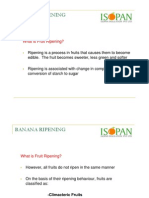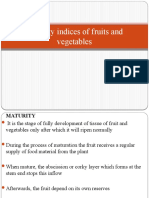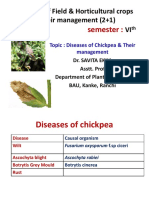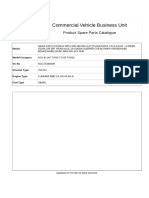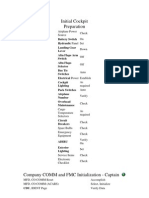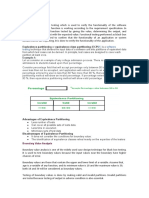0 ratings0% found this document useful (0 votes)
276 viewsCourse: Post Harvest Management and Value Addition of Fruits and Vegetables
Course: Post Harvest Management and Value Addition of Fruits and Vegetables
Uploaded by
rahulThe document discusses fruit ripening and the changes that occur during the process, including cell wall changes, starch breakdown, organic acid and pigment changes, increased volatile compounds, and respiration. It distinguishes between climacteric fruits that can ripen off the plant through ethylene production, and non-climacteric fruits that will not ripen once picked. Methods to induce or delay ripening through ethylene treatment or storage conditions are also presented.
Copyright:
© All Rights Reserved
Available Formats
Download as PPTX, PDF, TXT or read online from Scribd
Course: Post Harvest Management and Value Addition of Fruits and Vegetables
Course: Post Harvest Management and Value Addition of Fruits and Vegetables
Uploaded by
rahul0 ratings0% found this document useful (0 votes)
276 views36 pagesThe document discusses fruit ripening and the changes that occur during the process, including cell wall changes, starch breakdown, organic acid and pigment changes, increased volatile compounds, and respiration. It distinguishes between climacteric fruits that can ripen off the plant through ethylene production, and non-climacteric fruits that will not ripen once picked. Methods to induce or delay ripening through ethylene treatment or storage conditions are also presented.
Original Title
Fruit ripening (3)
Copyright
© © All Rights Reserved
Available Formats
PPTX, PDF, TXT or read online from Scribd
Share this document
Did you find this document useful?
Is this content inappropriate?
The document discusses fruit ripening and the changes that occur during the process, including cell wall changes, starch breakdown, organic acid and pigment changes, increased volatile compounds, and respiration. It distinguishes between climacteric fruits that can ripen off the plant through ethylene production, and non-climacteric fruits that will not ripen once picked. Methods to induce or delay ripening through ethylene treatment or storage conditions are also presented.
Copyright:
© All Rights Reserved
Available Formats
Download as PPTX, PDF, TXT or read online from Scribd
Download as pptx, pdf, or txt
0 ratings0% found this document useful (0 votes)
276 views36 pagesCourse: Post Harvest Management and Value Addition of Fruits and Vegetables
Course: Post Harvest Management and Value Addition of Fruits and Vegetables
Uploaded by
rahulThe document discusses fruit ripening and the changes that occur during the process, including cell wall changes, starch breakdown, organic acid and pigment changes, increased volatile compounds, and respiration. It distinguishes between climacteric fruits that can ripen off the plant through ethylene production, and non-climacteric fruits that will not ripen once picked. Methods to induce or delay ripening through ethylene treatment or storage conditions are also presented.
Copyright:
© All Rights Reserved
Available Formats
Download as PPTX, PDF, TXT or read online from Scribd
Download as pptx, pdf, or txt
You are on page 1of 36
Course: Post Harvest Management and
Value Addition of Fruits and Vegetables
(6th Semester)
Lecture 2: Fruit Ripening and Changes occurring
during Ripening
Presented by
Dr. Asmita
Department of Horticulture
BAU, Ranchi
e-mail: asmitakumari97@gmail.com
Fruit ripening is a genetically programmed stage of
development overlapping with senescence.
The fruit is said to be ripe when it attains its full flavour
and aroma and other characteristics of the best fruit of
that particular cultivar.
The words “mature “and “ripe” are essentially
synonymous when used to describe these fruits that ripe
on the plants known as non-climacteric.
However, in case of climacteric fruits, a mature fruit
require period before attaining a desirable stage of
edibility.
Climacteric and Climacteric Non-climacteric fruits
Climacteric fruits Non-climacteric fruits
That can ripen after being Will not ripen, once separated
picked/harvested. from the plant.
Enhanced rate of ethylene Produce very small amount of
production and respond to ethylene and don’t respond to
ethylene treatment. ethylene treatment.
Increased rate of respiration or No characteristics increased
production of carbon dioxide. rate of respiration or
production of carbon dioxide.
Apple, Apricot, Avocado, Banana, Carambola, Cherries, Citrus,
Ber, Cherimoya, Fig, Guava, Grape, Litchi, Loquat, Olive,
Kiwifruit, Mango, Melons, Pear, Pineapple, Pomegranate,
Peach, Plum, Persimmon, Papaya, Strawberry are non-climacteric
Tomato, Sapota, Passion fruit are fruits.
the climacteric fruits.
Green Banana
Changes during Fruit Ripening
Cell Wall Changes
Starch
Organic acids
Colour
Flavouring
Compounds
Ascorbic Acid
Phenolics
Amino Acids and
Proteins
Respiration
Changes during Fruit Ripening
Cell Wall Changes
Cell wall consists of pectic substances and cellulose
as the main components along with small amounts
of hemicellulose and non-cellulosic polysaccharides.
In cell wall, the changes particularly in the middle
lamella which is rich in pectic polysaccharides are
degraded and solubilized during ripening.
During this softening, there is a loss of neutral sugars
(galactose and arabinose-major components of
neutral protein) and acidic pectin
(rhamnogalacturonan) of all cell wall.
The major enzymes implicated in the softening of
fruits are hydrolase, pectinase, kinase, amylase etc.
Starch
During fruit ripening, sugar levels within fruit tend to
increase due to either increased sugar importation from
the plant or to the mobilization of starch reserves within
the fruit, depending on the fruit type and whether it is
ripened on or off the plant.
With the advancement of maturity, the accumulated
starch is hydrolysed into sugars (glucose, fructose or
sugars) which are known as a characteristic event for
fruit ripening.
Further breakdown of sucrose into glucose and fructose
is probably mediated by the action of invertase.
In vegetables like potato and peas on the other hand,
the higher sucrose content which remains high at fresh
immature stage, converts into starch with the approach
of maturity.
Organic Acids
With the onset of fruit ripening there is
downward trend in the levels of organic acids.
The decline in the content of organic acids during
fruit ripening might be the result of an increase in
membrane permeability which allows acids to be
stored in the respiring cells, formation of salts of
malic acid, reduction in the amounts of acid
translocated from the leaves, reduced ability of
fruits to synthesize organic acids with fruit
maturity, translocation into sugars and dilution
effect due to the increase in the volume of fruit.
Colour
The most obvious change which take place is the
degradation of chlorophyll and is accompanied by
the synthesis of other pigments usually either
anthocyanins or carotenoids.
They can give rise to a wide range of colours (from
red to blue).
The chloroplasts in green immature fruit generally
lose chlorophyll on ripening and change into
chromoplasts which contain carotenoid pigments.
Carotenoids are normally synthesized in green plant
tissue a major product being 3-carotene. However,
in many fruits additional carotene and lycopene is
synthesized during ripening.
Flavouring Compounds
Although fruit flavour depends on the
complex interaction of sugars, organic
acids, phenolics and volatile compounds
but the characteristic flavour of an
individual fruit or vegetable is derived
from the production of specific flavouring
volatile compounds.
These compounds are mainly esters,
alcohols, aldehydes, acids and ketones.
Ascorbic Acid
L-ascorbic acid (Vitamin C) is the naturally
occurring ascorbic acid in fruits.
A reduced amount of ascorbic acid is noticed in
pome, stone and berry fruits at the time of
harvest.
An increase in ascorbic acid content with the
increase in fruit growth has been and the levels
declined with the advancement of maturity and
onset of fruit ripening in pear, sweet potatoes,
potato, asparagus and okra during the course of
post harvest handling.
Phenolics
The phenolic content of most fruits declines
from high levels during early growth to low
levels when the fruit is considered to be
physiologically mature
Thereafter, susceptible to the induction of
ripening.
Amino Acids and Proteins
Decrease in free amino acid which often reflects
an increase in protein synthesis.
During senescence the level of free amino acids
increases reflecting a breakdown enzymes and
decreased metabolic activity.
Ethylene Production and Respiration
Physiological events responsible to ripening
process are as follows
Ethylene production
Rise in respiration
Ethylene production in climacteric fruits
such as mango, banana, ethylene increase
and causes:
• Rise in respiration
• Rise in temperature
• Rise in activity of hydrolytic enzymes.
Ethylene is produced from an essential amino acid
-methionine. Following the steps as below:
SAM: S′adenosyl methionine
ACC: 1-Aminocyclopropane-1-carboxylic acid
Rise in respiration
Respiration is required for releasing energy and the
substrate for synthesis of several organic compounds
required in the ripening process.
During ripening in climacteric fruits, there is rise in
respiration called climacteric. The climacteric peak is
obtained very fast when temperature is relatively high.
Respiration is a most deteriorating process of the harvested
fruits and vegetables which leads to the oxidative
breakdown of the complex materials (carbohydrates or
acids) of cell into simpler molecules (CO2 and water) with
the concurrent production of energy required by the cell for
the completion of chemical reactions.
In brief, the process of respiration can be summed up with
the following reaction: C6H1206 +6O2 6 CO2 + 6 H20 +
energy
Different Ripening Methods
Calcium carbide (CaC2): widely used chemical to
hasten the ripening (release acetylene gas)
Contains traces of arsenic and phosphorus (toxic
and hazardous to health, believed to affect the
nervous system by reducing the supply of oxygen to
the brain)
It is banned under 44-AA of PFA Rules, 1955.
Different Ripening Methods
Ripening with Artificial ethylene
Safe method
Natural gaseous plant hormone emitted by
fruits as ripening initiates.
Commercial form: Ethrel or ethaphon (2-
chloroethane phosphonic acid)
Use of ethylene to promote ripening is permitted
under FDA Regulation 120, 1016.
• Application of ethephon promotes degreening
and early ripening in grape, tomato, coffee, pear,
plum, peach and citrus.
• Smoking is commercially employed to hasten de-
greening and ripening of banana and mango.
De-greening in citrus: Carried out in ripening room and this
process takes 2-3 days.
Ventilate daily to ensure that CO2 level does not exceed to 1%
The most rapid de-greening occurs at temperature between 25-
30°c but the best colour development occurs at 15-25°c.
De-greening improves external skin colour and market
acceptance.
Artificial ripening of Tomatoes
How to minimize ethylene production and increase the shelf life????
Temperature regulation
With increase in temperature, rate of ripening
increases
Storage at low temperature reduce the rate of respiration
and ethylene production.
Storing at low temperature below the optimum level results in
cold injury and decrease in fruit quality. For example, mango is
stored at 8-13°c
Regulation of storage atmosphere
Natural atmospheric air is conductive for the ethylene
synthesis.
Decreasing O2 concentration below 5% and increasing CO2
concentration between 3 to 10% delayed ripening by inhibiting
ethylene.
Use of Chemicals for Increasing Shelf Life of Fruits and Vegetables
1. Ethylene absorbent: Ethylene is responsible for decreasing
shelf life. KMnO4 is a good ethylene absorbent. Putting KMnO4
@ 100 ppm soaked filter paper can minimized ripening and
increase shelf life. In Banana, this method is very useful.
2. Antifungal Agents
• SOPP: Sodium orthophenylphenate
• Diphenyl wraps provide protection against moulds, stem-end
rot.
• Dibromoletrachloroethane and esters give better flavour.
3. Use of Inhibitors
Treatment Crop Chemical Concentration
Post-harvest Mango MH 1000-2000 ppm
After fruit Apple 2-Dimethyl- 10,000 ppm
formation hydrazide
4. Use of Auxins: helpful to advance in ripening
and may increase shelf life.
Chemical Concentration Crop Stage
2,4-D 5 ppm Grape Pre-harvest
2,4,5-T 25 ppm Fig Pre-harvest
2,4,5-T 100 ppm Mango After harvesting
5. Vegetables can be preserved by lactic acid and
may increase the shelf life.
6. Post harvest dipping of papaya fruits either in l00
ppm GA3 or CaCl2 al 2% extended shelf life up to 9
days without any decline in quality.
You might also like
- Control of Communicable Diseases ManualDocument715 pagesControl of Communicable Diseases ManualChris Mahfood100% (5)
- Banana Ripening ProcessDocument16 pagesBanana Ripening ProcessFajar SungkarNo ratings yet
- Preventing The Browning of Sliced FruitDocument12 pagesPreventing The Browning of Sliced FruitCYNTHIA100% (1)
- Dragon Fruit Wine MakingDocument43 pagesDragon Fruit Wine MakingdiestoNo ratings yet
- Cucumis Sativus (Cucumber)Document22 pagesCucumis Sativus (Cucumber)Narongchai PongpanNo ratings yet
- FERMENTATION Vinegar PDFDocument22 pagesFERMENTATION Vinegar PDFJivashiniBalasupurManiam100% (1)
- Artificial Ripening of Fruits: Presented by Tamilselvan - TDocument48 pagesArtificial Ripening of Fruits: Presented by Tamilselvan - Trajat sharmaNo ratings yet
- Fruit Ripening by Prof S. N. Naik, IIT DelhiDocument6 pagesFruit Ripening by Prof S. N. Naik, IIT DelhiWes D Gordon100% (1)
- Maturity, Ripening & StorageDocument51 pagesMaturity, Ripening & Storagerajat sharmaNo ratings yet
- Apple For Banana RipeningDocument4 pagesApple For Banana RipeningRay Christian FaustinoNo ratings yet
- Addis Ababa Science and Technology University College of Biological and Chemical Engineering Department of Chemical EngineeringDocument54 pagesAddis Ababa Science and Technology University College of Biological and Chemical Engineering Department of Chemical EngineeringmikialeNo ratings yet
- Fermentation Characteristics of Star Aplle RindDocument25 pagesFermentation Characteristics of Star Aplle RindBueno, Signorina Y. UnknownNo ratings yet
- Banana Ripening: What Is Fruit Ripening?Document38 pagesBanana Ripening: What Is Fruit Ripening?Alok SrivastavaNo ratings yet
- SYZYGIUM SAMARANGESE (Macopa) Fruit As A Natural Fruit Juice A. Background of The StudyDocument8 pagesSYZYGIUM SAMARANGESE (Macopa) Fruit As A Natural Fruit Juice A. Background of The StudyClarisse DacasinNo ratings yet
- New VersionDocument10 pagesNew VersionMorino FuugaNo ratings yet
- Introduction WineDocument2 pagesIntroduction WineMarielle PerejonNo ratings yet
- Extraction of Orange Oil From PeelDocument24 pagesExtraction of Orange Oil From PeelRajeswari Raji33% (3)
- 20 Lemon LiteratureDocument31 pages20 Lemon LiteraturePaul Lau100% (2)
- 4th Lecture - Minimal Processing and Dehydration of Fruits & VegetablesDocument28 pages4th Lecture - Minimal Processing and Dehydration of Fruits & VegetablesMeraki PortraitNo ratings yet
- Group 2 - Post Lab Activity 9 (Pcog Finals)Document10 pagesGroup 2 - Post Lab Activity 9 (Pcog Finals)Florence Lynn BaisacNo ratings yet
- Thesis For Research Proposal-MsaDocument31 pagesThesis For Research Proposal-MsaISCCNo ratings yet
- Utilization of Mango Peels and Seed Kernels Powders As Sources of Phytochemicals in BiscuitDocument8 pagesUtilization of Mango Peels and Seed Kernels Powders As Sources of Phytochemicals in BiscuitbarenakedearthNo ratings yet
- Cabbage - Post-Harvest Handling and StorageDocument2 pagesCabbage - Post-Harvest Handling and Storagetinaa123456789No ratings yet
- Pride Ethyl AlcoholDocument24 pagesPride Ethyl AlcoholKUKUNo ratings yet
- Title PagesDocument19 pagesTitle PagesMegan Joy ZaratanNo ratings yet
- Biochemical and Physiological Changes During RipeningDocument25 pagesBiochemical and Physiological Changes During RipeningAGRI KUDUMIYANMALAINo ratings yet
- The Problem and Its Background of The StudyDocument47 pagesThe Problem and Its Background of The Studykirl española100% (1)
- 0 - Chapter II. Review of Related LiteratureDocument13 pages0 - Chapter II. Review of Related LiteratureJiyan LitohonNo ratings yet
- Plantain Chips ProposalDocument4 pagesPlantain Chips Proposalzeus100% (1)
- Chapters 1 5Document19 pagesChapters 1 5Ann Renette Uy100% (1)
- Dragon Fruit WineDocument23 pagesDragon Fruit WineKiran Waghmode100% (1)
- Review of Related Literature: Figure2.1 Coconut FruitDocument24 pagesReview of Related Literature: Figure2.1 Coconut FruitJun Ace S. BieteNo ratings yet
- Production of Higth Quality Fish OilDocument208 pagesProduction of Higth Quality Fish Oiltranphongnha1987636No ratings yet
- ThesisDocument22 pagesThesisCHOYSON RIVERALNo ratings yet
- Guava Wine pdf1 PDFDocument10 pagesGuava Wine pdf1 PDFrammeshbankarNo ratings yet
- Act 4 Wine and Vinegar ProductionDocument2 pagesAct 4 Wine and Vinegar ProductionDS ZyxNo ratings yet
- Fermented Alcoholic Beverage: A Banana Wine InventionDocument16 pagesFermented Alcoholic Beverage: A Banana Wine InventionNickolaNo ratings yet
- Thesis Work About Market DesignDocument146 pagesThesis Work About Market DesignShawul Gulilat100% (3)
- Jurnal Virgin Coconut Oil (VCO)Document8 pagesJurnal Virgin Coconut Oil (VCO)Tamam Ibrahim SatrioNo ratings yet
- Biological Aspects of Post Harvest Handling: Joel Solomo BalindanDocument96 pagesBiological Aspects of Post Harvest Handling: Joel Solomo BalindanPETER PAUL ESTILLERNo ratings yet
- STAR FRUIT - Carambola: Kamrakh (Indian) Chinese Starfruit, Star Apple and Five Angled Fruit. Today They Are Also GrownDocument5 pagesSTAR FRUIT - Carambola: Kamrakh (Indian) Chinese Starfruit, Star Apple and Five Angled Fruit. Today They Are Also GrownSoledayo Tom OsuntuyiNo ratings yet
- High Fructose Corn SyrupDocument10 pagesHigh Fructose Corn Syrupapi-352509673No ratings yet
- GandaraDocument25 pagesGandaraJayson Fabrigas VillafrancaNo ratings yet
- SjheDocument19 pagesSjheSwyne FaytarenNo ratings yet
- Experiment 1 WinemakingDocument6 pagesExperiment 1 WinemakingEllen Jane RamosNo ratings yet
- An Integrated Approach For Mango Solid Waste UtilizationDocument5 pagesAn Integrated Approach For Mango Solid Waste UtilizationMo ZeroNo ratings yet
- PHD Thesis ADMS A4formatDocument261 pagesPHD Thesis ADMS A4formatCt NurhanaNo ratings yet
- Effect of Size Reduction On The Extraction of Palm Kernel OilDocument41 pagesEffect of Size Reduction On The Extraction of Palm Kernel OilAppeal MatthewNo ratings yet
- Need of The ProjectDocument8 pagesNeed of The Projecttayyaba mehmoodNo ratings yet
- RRL Only (31jan2016)Document20 pagesRRL Only (31jan2016)Ali DandamunNo ratings yet
- A Comparative Study of The Effectiveness of Stearic Acid in Preventing Rust by Group 3. IV-marxDocument24 pagesA Comparative Study of The Effectiveness of Stearic Acid in Preventing Rust by Group 3. IV-marxLuzvi RamosNo ratings yet
- Related Literatures and StudiesDocument3 pagesRelated Literatures and StudiesAnonymous kQNmnnefNo ratings yet
- Production of Wine From Banana: Waffen-Und Kostumkunde Journal ISSN NO: 0042-9945Document21 pagesProduction of Wine From Banana: Waffen-Und Kostumkunde Journal ISSN NO: 0042-9945Jerico D. Campos100% (1)
- Vinegar and Its Production ADocument13 pagesVinegar and Its Production ANagaraj Mehtry90% (10)
- Food TechnologyDocument4 pagesFood TechnologyAnonymous dzcacBy5DNo ratings yet
- FDA Phil Revised Guidelines For The Assessment of Microbiological Quality of Processed FoodsDocument12 pagesFDA Phil Revised Guidelines For The Assessment of Microbiological Quality of Processed FoodsclairealbertiniNo ratings yet
- Production of Bioethanol Form Soursop Fruit PulpDocument39 pagesProduction of Bioethanol Form Soursop Fruit PulpAngel Lou DatuNo ratings yet
- Spray Drying Technique of Fruit Juice Powder: Some Factors Influencing The Properties of ProductDocument10 pagesSpray Drying Technique of Fruit Juice Powder: Some Factors Influencing The Properties of ProductNanda AngLianaa KambaNo ratings yet
- Maturity Indices of Fruits and VegetableDocument24 pagesMaturity Indices of Fruits and Vegetablearid132100% (1)
- Principles of Postharvest Physiology Lecture 8 20 2015bDocument69 pagesPrinciples of Postharvest Physiology Lecture 8 20 2015bJoyce De VeraNo ratings yet
- Honeybee 1Document14 pagesHoneybee 1rahulNo ratings yet
- Lecture - 3 PRAMODSIRDocument69 pagesLecture - 3 PRAMODSIRrahulNo ratings yet
- Lecture - 2PRAMOD RAIDocument52 pagesLecture - 2PRAMOD RAIrahulNo ratings yet
- Diseases of Chickpea PDFDocument19 pagesDiseases of Chickpea PDFrahul100% (1)
- Birsa Agricultural University: Ranchi (Jharkhand) IndiaDocument49 pagesBirsa Agricultural University: Ranchi (Jharkhand) IndiarahulNo ratings yet
- Discussion of Agri KnowledgeDocument24 pagesDiscussion of Agri KnowledgerahulNo ratings yet
- Class - Pramod RaiDocument1 pageClass - Pramod RairahulNo ratings yet
- Code 06: Major Subject Group - Social Sciences: Unit-IDocument1 pageCode 06: Major Subject Group - Social Sciences: Unit-IrahulNo ratings yet
- AdjuvantsDocument16 pagesAdjuvantsrahulNo ratings yet
- Optional Lecture 3: Wall Boiling Models: 16.0 ReleaseDocument56 pagesOptional Lecture 3: Wall Boiling Models: 16.0 ReleasemNo ratings yet
- Antimicrobial Approach To Intra-Abdominal Infections in Adults - UpToDateDocument29 pagesAntimicrobial Approach To Intra-Abdominal Infections in Adults - UpToDatecontateste197789No ratings yet
- A New Method For Mining Maximal Frequent Itemsets Based On Graph TheoryDocument6 pagesA New Method For Mining Maximal Frequent Itemsets Based On Graph TheoryBobNo ratings yet
- Signa 4923 Trailer Part CatalougeDocument218 pagesSigna 4923 Trailer Part CatalougeAman DeepNo ratings yet
- Initial Cockpit Preparation 777Document15 pagesInitial Cockpit Preparation 777Mayur SonejiNo ratings yet
- Si Man ChapDocument17 pagesSi Man ChapThettinAungNo ratings yet
- CERN Brochure 2015 004 EngDocument2 pagesCERN Brochure 2015 004 EngDeBrialmontNo ratings yet
- Unit 2Document13 pagesUnit 2Devanshi ShahNo ratings yet
- Ravikala PandugaDocument118 pagesRavikala Pandugaresearch data767% (6)
- BGF F ProdDocument13 pagesBGF F Proddidi sudiNo ratings yet
- Baudrillard KDocument60 pagesBaudrillard KAyden Loeffler100% (2)
- Geomorphic HazardsDocument22 pagesGeomorphic HazardsSANJAY KUMAR YADAV MtechNo ratings yet
- Decomposition Reactions With Examples - Ic18193Document3 pagesDecomposition Reactions With Examples - Ic18193zkyNo ratings yet
- A Ritual of Fire Sacrifice To The Green TaraDocument12 pagesA Ritual of Fire Sacrifice To The Green TaraJohn Kelly100% (1)
- Case Study of JIT PDFDocument59 pagesCase Study of JIT PDFTu TuNo ratings yet
- Vegetative DisordersDocument55 pagesVegetative DisordersAnil NarayanNo ratings yet
- Seismic Refraction MethodDocument14 pagesSeismic Refraction MethodIkhsan KurniawanNo ratings yet
- Elementary Algebra - Third Periodical ExaminationDocument6 pagesElementary Algebra - Third Periodical ExaminationRemalyn Quinay CasemNo ratings yet
- Lec 2Document9 pagesLec 2hsyffwfwhsusgNo ratings yet
- LS01 - Culture in Vernacular Architecture - Worksheet PDFDocument18 pagesLS01 - Culture in Vernacular Architecture - Worksheet PDFpepito manalotoNo ratings yet
- Test Bank For Animal Diversity, 8th Edition by Cleveland Hickman, Keen, LarsonDocument16 pagesTest Bank For Animal Diversity, 8th Edition by Cleveland Hickman, Keen, Larsonbennettrowan01No ratings yet
- SMS W 0771 Instruction For Management of Ship-To-Ship TransferDocument3 pagesSMS W 0771 Instruction For Management of Ship-To-Ship Transferyandong liNo ratings yet
- Soal Mid-Semester Bing 2021Document4 pagesSoal Mid-Semester Bing 2021rizky andika suwardiNo ratings yet
- 01 EDITH WHARTON, The Writing of FictionDocument9 pages01 EDITH WHARTON, The Writing of FictionzorankyuNo ratings yet
- Dan 2019 IOP Conf. Ser. Mater. Sci. Eng. 568 012078Document6 pagesDan 2019 IOP Conf. Ser. Mater. Sci. Eng. 568 012078ficioruNo ratings yet
- Dispensing Per TGL 22 Januari 2022 (H1)Document6 pagesDispensing Per TGL 22 Januari 2022 (H1)Jajat Rahayu EkaNo ratings yet
- 4 - Muhammad Arvianda Kevin KurniaDocument16 pages4 - Muhammad Arvianda Kevin KurniaMuhammad Ali Syahrun MubarokNo ratings yet
- Dana Spicer 2 - 4266588 - 15.5HR36432-36 - TPL-2626 - 2015-10-08Document76 pagesDana Spicer 2 - 4266588 - 15.5HR36432-36 - TPL-2626 - 2015-10-08sathya100% (1)
- The Rise of Urban Farming - Transforming Cities Into Green HavensDocument2 pagesThe Rise of Urban Farming - Transforming Cities Into Green HavensMitioNo ratings yet












